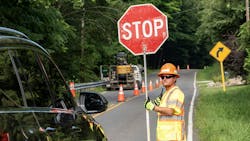Protection from the Unexpected
By Cornelius Morgan, Contributing Author
Each year, thousands of crashes happen in work zones, and most of the people hurt or killed aren’t even the workers. About 85% of work zone fatalities are actually drivers and their passengers according to the Federal Highway Administration (FHWA).
But for road construction companies, the risk to crews on the ground is real. The biggest question project managers and other industry leaders need to ask themselves is this:
Are you doing everything possible to keep your workers safe from unsafe drivers?
Crash Causes
It’s no surprise—reckless driving is the leading cause of work zone crashes, and the same bad habits keep showing up.
- Speeding: Work zones have speed limits for a reason. According to the FHWA, in 2020 alone, almost 300 people died in work zones because drivers were going too fast to react in time.
- Distracted Driving: Including all roadways, the National Highway Traffic Safety Administration reports that 3,308 people died in distraction-affected crashes in 2022. Also consider that the percent of drivers manipulating hand-held electronic devices (think text messaging) has increased from 1.7% in 2013 to 3.1% in 2022—that’s 82% more high-risk activity at any given time.
- Tailgating: Following too close to the vehicle in front of you in a work zone is a recipe for disaster. It’s why rearend crashes make up a staggering 37% of all accidents in these areas.
- Ignoring Signs and Flaggers: Cones, barrels and flaggers are there to keep everyone safe—but too many drivers ignore the signs. Traffic flagger deaths are in fact part of a bigger, tragic statistic. According to the Bureau of Labor Statistics, "transportation and material moving occupations" saw 1,495 fatalities in 2023—the highest of any job category. And while flaggers comprise only a small fraction of this number, dozens are injured or killed on the job every year.
Costs Beyond Lives Lost
It’s not just the tragic loss of life that makes work zone safety critical. The financial cost of work zone crashes is staggering. Just one reckless driver can mean big trouble for your company—lawsuits, delays that eat into profits, rising insurance rates and thousands in damaged equipment.
Dangerous driver behavior is out of your hands, but protecting your team isn’t. Here are some smart ways to make work zones safer:
- Don’t give drivers an excuse to say, ‘I didn’t see them.’ Maximize lighting, use reflective gear and add digital signage to make your team stand out.
- A layer of concrete can mean the difference between a close call and a tragedy. Barriers and truck-mounted attenuators give your crew real protection from reckless drivers.
- Nothing grabs a driver’s attention like flashing blue lights. A police presence near work zones can cut speeding significantly—because sometimes, a ticket is the only wake-up call that works. The Pennsylvania Department of Transportation reported that during its Work Zone Speed Enforcement pilot program, speeding violations decreased by 38%, and excessive speeding (11-plus mph over the limit) dropped by 47% during peak construction seasons from 2020 to 2022.
Drivers make mistakes—your crew shouldn’t have to pay for them. Train workers to stay alert for reckless drivers and know exactly where to go if danger comes their way.
When the shift is over, your workers should be heading home, not to the hospital. Unsafe driving won’t go away, but strong safety measures—better lighting, protected work areas, slower speeds—can make sure your team stays safe. No deadline is worth a life.
Cornelius Morgan is the Sr. Director of EHS North America at AWP Safety, where he champions environmental health and safety initiatives across the organization.
